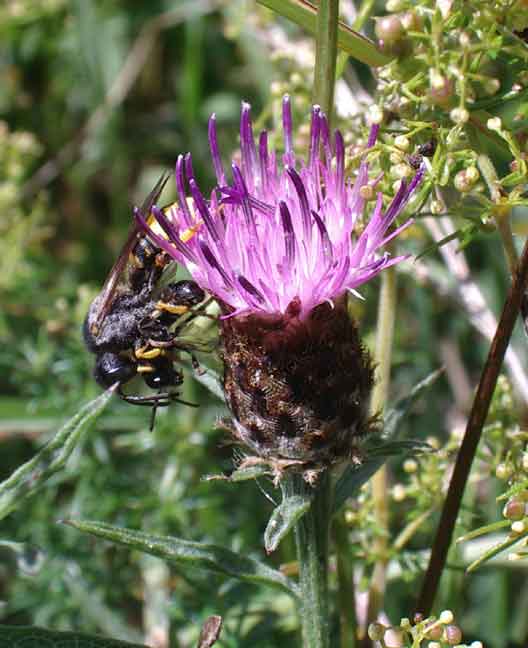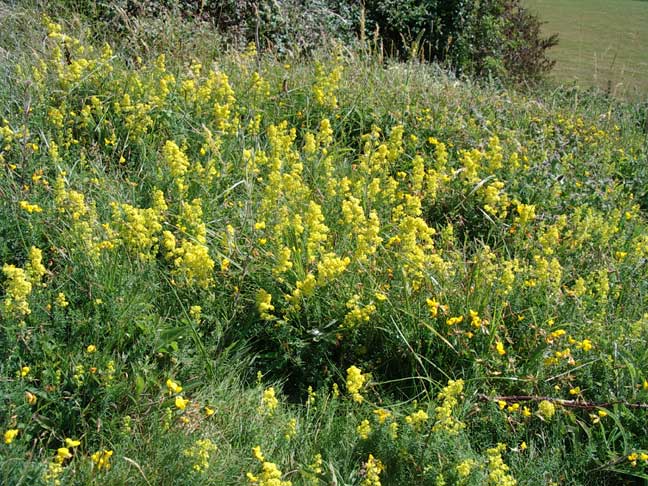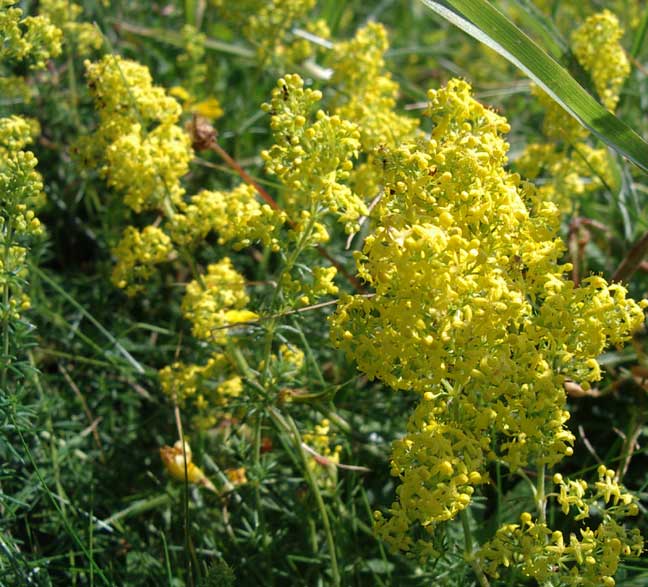
I have
identified the top one as possibly a Digger
Wasp, Cerceris
rybyensis, which has attacked the small bee which it will paralyse
and then kidnap.
Mill Hill Images
Extra Images from the Upper Slopes only
 |
There
are two insects in this picture.
I have
identified the top one as possibly a Digger
Wasp, Cerceris
rybyensis, which has attacked the small bee which it will paralyse
and then kidnap.
ID
by Matt Smith on British
Insects (Yahoo Group)
|
6 July
2004
 |
 |
 |
10
May 2004
East
of Mill Hill, the first Rook
appeared, followed by a pair east of Erringham Hill, and at Anchor
Bottom and Beeding Hill to the north over 300
Rooks probed in the grasslands.
 |
 |
|
|
Roadside vegetation on the east side by gate near the reservoir |
Fumaria officinalis ID by Ray Hamblett |
There
were clumps of Agrocybe mushrooms
and the first emergence of Bird's Foot Trefoil.
Fungi
of the Downs in May 2004
Fungi
of Shoreham
26
April 2004
On
the open upper slopes of Mill Hill there
was a Brimstone Butterfly
and a handful of Small Tortoiseshells,
orange in colour but not fresh, the orange dulled by age.
Adur
Butterflies Flight Times
Adur
Butterflies
The
Common
Carder Bee, Bombus
pascuorum, with is orange furry thorax
was buzzing around the grass at the southern end, near the Blackthorn
bushes on the east side midway between the car park and the reservoir.
This species is the third most common bumblebee species on Mill Hill.
Adur
Bumblebees
 |
 |
On
the upper
slopes of Mill Hill the Morels
were dried out and at least one of two toadstools appeared to be eaten
out from the inside (they are hollow inside).
Fungi
of Shoreham
Mill
Hill Nature Reserve
20
April 2004
It
was the long probing beak on the short turf of a Rook
on the top of Mill Hill that gave it away. Its grey face was apparent
even before I fastened my binoculars on this solitary corvid. Only about
one in a thousand large black corvids locally are Rooks,
the rest are Crows
with Jackdaws
classed as small.
 A
solitary toadstool was amongst the still short grass near a Hawthorn bush.
I recognised it immediately as a Morel,
Morchella
esculenta, because of its unusual distinctive
appearance. I had not seen one before and although an edible species, I
left it in its place just south of the car park.
A
solitary toadstool was amongst the still short grass near a Hawthorn bush.
I recognised it immediately as a Morel,
Morchella
esculenta, because of its unusual distinctive
appearance. I had not seen one before and although an edible species, I
left it in its place just south of the car park.
The
male
Kestrel
hovered
over the lower slopes, whereas the female
was seen at a much lower trajectory flying over the copse.
Adur
Fungi: Fruiting Times
Fungi
of Shoreham
A further
check on the violets
of Mill Hill revealed that the violets
on the upper slopes (the Triangle) and the
scrub
in the north-west were all Sweet Violets,
and the violets
on the lower slopes were almost all Dog
Violets.
Violets
of Mill Hill
15
April 2004
Red
Campion, Daffodils and
Bluebells
were
in flower above the ridge on the upper slopes. The Violets
were overgrown or diminished. A Kestrel
hovered over the ridge and it dived, wings pinned close to its body for
an impressive display. Brown-tail,
Euproctis chrysorrhea,
Moth caterpillars clambered over a Hawthorn. This
moth species is a pest of fruit trees.
 |
 |
 |
 22
March 2004
22
March 2004
The
Sweet
Violets at the top of the wooded slopes
on the southern section of Mill Hill looked
battered by the gales and hail of the last two days.
Violet
Images from the Lower Slopes (Link) (April 2004)
Violets
of Mill Hill
The
Buff-tailed
Bumblebee, Bombus
terrestris, was the species present,
a solitary one observed, and this is the commonest and most noticable local
species.
British
Bumblebee Checklist
Link
to the Mill Hill WILDLIFE REPORTS up to 2003
with
lots of Butterfly observations
Lower
Slopes (with Butterfly Reports)
 MultiMap
Aerial Photograph of Mill Hill
MultiMap
Aerial Photograph of Mill Hill
Back
to Mill Hill
Triangle
Upper
Slopes
Middle
Slopes
Lower
Slopes
Grasses
of Mill Hill
Mill
Hill Copse
Aerial
Map
Lower
Adur Levels (MultiMap) including Lancing Clump and Mill Hill
Hippocrepis
comosa (Horseshoe Vetch)